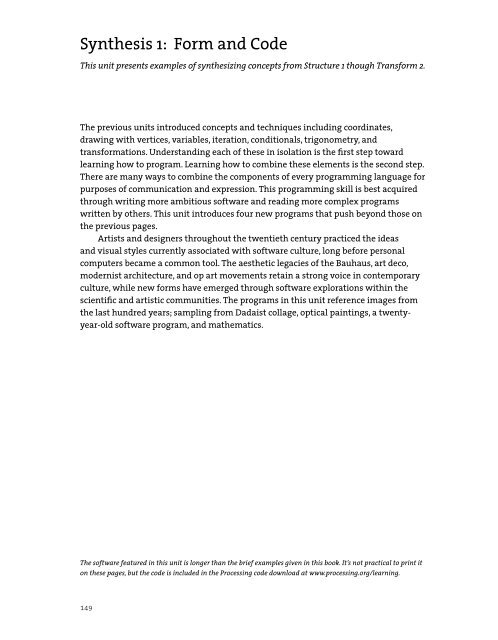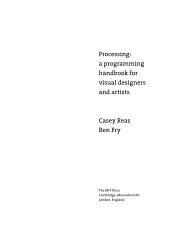Fractal.Invaders, Substrate (Interview with Jared Tarbell) - Processing
Fractal.Invaders, Substrate (Interview with Jared Tarbell) - Processing
Fractal.Invaders, Substrate (Interview with Jared Tarbell) - Processing
You also want an ePaper? Increase the reach of your titles
YUMPU automatically turns print PDFs into web optimized ePapers that Google loves.
Synthesis 1: Form and Code<br />
This unit presents examples of synthesizing concepts from Structure 1 though Transform 2.<br />
The previous units introduced concepts and techniques including coordinates,<br />
drawing <strong>with</strong> vertices, variables, iteration, conditionals, trigonometry, and<br />
transformations. Understanding each of these in isolation is the fi rst step toward<br />
learning how to program. Learning how to combine these elements is the second step.<br />
There are many ways to combine the components of every programming language for<br />
purposes of communication and expression. This programming skill is best acquired<br />
through writing more ambitious software and reading more complex programs<br />
written by others. This unit introduces four new programs that push beyond those on<br />
the previous pages.<br />
Artists and designers throughout the twentieth century practiced the ideas<br />
and visual styles currently associated <strong>with</strong> software culture, long before personal<br />
computers became a common tool. The aesthetic legacies of the Bauhaus, art deco,<br />
modernist architecture, and op art movements retain a strong voice in contemporary<br />
culture, while new forms have emerged through software explorations <strong>with</strong>in the<br />
scientifi c and artistic communities. The programs in this unit reference images from<br />
the last hundred years; sampling from Dadaist collage, optical paintings, a twentyyear-old<br />
software program, and mathematics.<br />
The software featured in this unit is longer than the brief examples given in this book. It’s not practical to print it<br />
on these pages, but the code is included in the <strong>Processing</strong> code download at www.processing.org/learning.<br />
149



